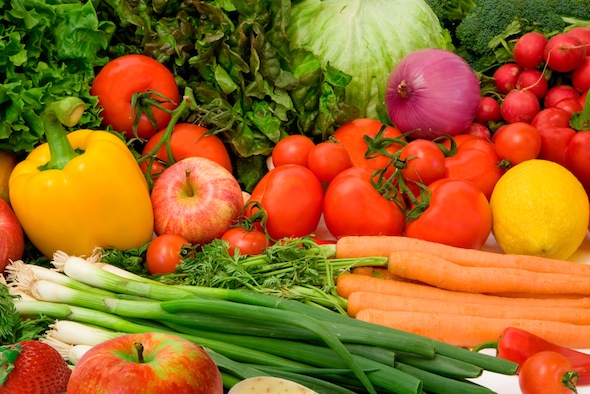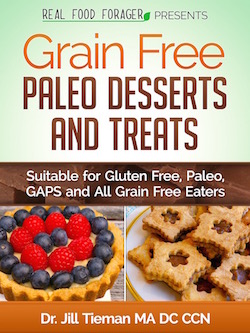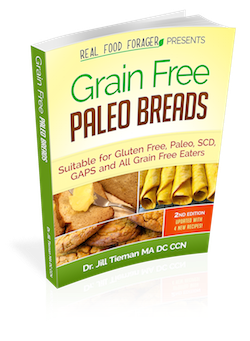In the New York Times Sunday Review this week, there was a fascinating article written by Jo Robinson (author of the upcoming book, “Eating on the Wild Side: The Missing Link to Optimum Health”). The article, entitled Breeding the Nutrition Out of Our Food, deals with a problem in our food supply that may surprise you.
We Need To Revise the Directive to Eat Plenty of Fruits and Vegetables
Robinson states that the health directive to eat plenty of fruits and vegetables in order to to be healthy, has to be revised, because most of our modern fruits and vegetables have been breed to enhance sweet taste without regard to the huge decrease in health promoting anthocyanins that protect us from oxidative stress.
Additionally, this has nothing to do with organic versus conventional growing methods. It goes back to when we became agriculturists and abandoned the hunter/gatherer diet of wild foods thousands of years ago. Over time, we unintentionally, made choices about feeding livestock and what to plant in gardens that consistently decreased the amount of nutrients and antioxidants in the food. This has compromised our ability to experience radiant health and has lead to the epidemic of chronic disease that we have today.
Anti-Oxidants Protect Us From Disease
Antioxidants consist of a group of vitamins, minerals and enzymes that help bind up harmful metabolic by-products called “free radicals” that can lead to tissue and DNA damage, cancer, heart disease, diabetes and other age-related diseases.
Free radicals are highly reactive compounds that are formed from normal metabolic functions in the body and also when our cells are exposed to a variety of substances such as radiation, chemicals, pollution, smoke, drugs, alcohol, pesticides and the sun. A poor diet also contributes to the formation of free radicals.
Anthocyanins — the Darker the Better
Anthocyanin (the pigment that makes blueberries blue) contains naturally occurring plant chemicals called polyphenols which have very high antioxidant characteristics. The darker, deeper blue fruits have the highest anthocyanin values, thereby supplying the most potent antioxidant sources.
Interestingly, since 2010 the USDA ORAC chart has been withdrawn because they are not sure how anti-oxidants values invitro relate to
There is no evidence that the beneficial effects of polyphenol-rich foods can be attributed to the antioxidant properties of these foods. The data for antioxidant capacity of foods generated by in vitro (test-tube) methods cannot be extrapolated to in vivo (human) effects and the clinical trials to test benefits of dietary antioxidants have produced mixed results. We know now that antioxidant molecules in food have a wide range of functions, many of which are unrelated to the ability to absorb free radicals… ORAC values are routinely misused by food and dietary supplement manufacturing companies to promote their products and by consumers to guide their food and dietary supplement choices.
For these reasons the ORAC table, previously available on this web site has been withdrawn.
I’m not sure how they measured the phytonutrient and anti-oxidant value of the heritage foods versus the domesticated varieties. Studies are mentioned and I hope the references will be in the book.
Corn Has More Problems Than Just Monsanto
One of the most obvious crops to be damaged is corn. Our modern corn is ruined. Anyone aware of the problems with genetic modification knows that 90% of the corn crop in this country is from genetically modified seeds from Monsanto.
Not only are these crops grown from GM seeds — they are also doused with loads of Monsanto’s Roundup (glyphosate) which leave plenty of pesticide residues that get into the food. Trust me, this is not safe to eat.
I won’t go near corn at all. Period. The only corn I would eat is from seeds that are heritage seeds (if that exists) and from a farmer that I know. I NEVER eat any dish with corn in it at a restaurant. Because I am grain free, this is not hard for me, but for the average person, it is very hard to avoid corn as it is in many commercial products.
History of Modern Day Corn
Beyond the problems with the modern day corn crop, is the history of it’s evolution.
It turns out that corn has been genetically modified since the 1920’s when, according to Robinson,
geneticists mutated the seeds by exposing them to X-rays, toxic compounds, cobalt radiation and then, in the 1940s, to blasts of atomic radiation. All the kernels were stored in a seed bank and made available for research.
In 1959 a geneticist named John Laughnan discovered that irradiated corn kernels were 10 times sweeter than ordinary sweet corn. That was the beginning of the hybridized corn which first sold in 1961.
This irradiated corn was first genetically modified food that slipped into our food supply. According to Robinson,
Today, most of the fresh corn in our supermarkets is extra-sweet, and all of it can be traced back to the radiation experiments. The kernels are either white, pale yellow, or a combination of the two. The sweetest varieties approach 40 percent sugar, bringing new meaning to the words “candy corn.” Only a handful of farmers in the United States specialize in multicolored Indian corn, and it is generally sold for seasonal decorations, not food.
How many other foods have been modified like corn without our knowledge? The push was to make the plant foods sweeter.
We have given up nutrient value for sugar. It’s no wonder we have an epidemic of chronic illness today. Even the vegetables and fruits have been modified to contain much less phytonutrients and anti-oxidants and much more sugar. — and we know how dangerous sugar can be for our health.
Sadly, even if a person eats only plant foods (and avoids commercial candy), they can still be getting too much sugar.
This Pattern of Alteration Carries Through to Many Other Foods
According to Robinson,
The United States Department of Agriculture exerts far more effort developing disease-resistant fruits and vegetables than creating new varieties to enhance the disease resistance of consumers. In fact, I’ve interviewed U.S.D.A. plant breeders who have spent a decade or more developing a new variety of pear or carrot without once measuring its nutritional content.
So true. They are so intent on making a cash crop, that no one mentions the issue of the decrease in nutrient value. As goes the packaged food industry, so goes the agriculturists.
Here Are the Foods Highest In Phytonutrients
- Corn: Use blue, red or purple corn meal — organic of course. Personally, I don’t use corn as staed above. Now I can add another reason to not eat corn.
- Greens: Arugula (salad rocket) is still very similar to the arugula of the past and is higher in anti-oxidants than most lettuce. Dandelion leaves have the highest amount of anti-oxidants of all the lettuces, far surpassing even spinach.
- Onions: Use scallions — they have more than five times the phytonutrients than many common onions do. Use the entire plant as the greens have more nutrients than the bulbs.
- Herbs: Most herbs have not been messed with because of their inherent flavors. Use them in your food as they have potent anti-oxidants and nutrients.
- Berries: Chokeberries far surpass blueberries in anti-oxidant value.
- Carrots: Purple carrots are modern heirlooms and these have much greater amounts of phytonutrients than typical orange carrots.
- Apples: Crab Apples have much greater amounts of phytonutrients than any of the modern varieties found in our markets today.
These foods are suggested by Robinson in the article. However, she is only addressing the nutrient value of plant foods. As an omnivore I would also add that many important nutrients may be obtained from animals that are raised on pasture. (I’ve read that she is also a proponent of pasture raised animals.)
Misleading Nutrition Information
The government guidelines to eat more fruits and vegetables are misleading people into thinking they can enjoy optimal health from a plant based diet. This is just not so.
Clearly, from the information in this article and from what we know about the necessary nutrients needed for optimal health, one has to eat more than just plants. Today’s modern plant foods are just a shadow of what they once were.
The real nutrient dense foods come from animals raised on pastures the way they should be raised. If you want to improve your health by eating nutrient dense food you need to eat animal products. How many of us have access to heritage plant foods? Not too many of us.
How to Access Nutrient Rich Animal Products
Contact your local Weston Price Chapter Leader for information on where to source nutrient rich foods.
Check out my Grain Free E-Class and E-Book Bundle on sale now through June 7. It’s all about real food.
How do you feel about this systemic assault on our food supply? Leave a comment and let me know!












